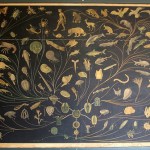history of science
The skull of Arsinoitherium, from A preliminary note on Arsinoitherium zitteli.
As spectacular as the extinct Eocene mammal Arsinoitherium was, many scientists were not all that interested in it. Its size and weapons were certainly impressive, but it appeared to sit on a difficult-to-define side branch of mammalian evolution. This made it a less attractive subject of study than some of its close relatives among the paenungulata, the elephants, whose evolutionary history could be traced in greater detail. As H.R. Knipe wrote in his Evolution in the Past, Arsinoitherium just seemed to be…
Students and laypeople alike often view biotech patents with baffled disbelief. How is it possible to patent bacteria? Mice? Cell types and DNA sequences? How can someone else "own" gene sequences that all of us have carried inside our bodies since birth?
Honestly, as a biologist, the concept of patenting a gene doesn't really throw me for a loop. Think about it: although we all have genes, we can't read them unless we use a variety of lab techniques, many of them patented. In turn, reading the sequence isn't any use unless we know why we care - that this gene is relevant and can be used to…
The giraffe-like restoration of Paraceratherium, from Natural History.
If I believed everything Hollywood told me I would accept that a paleontologist is someone who has a knack for finding numerous exceptionally-preserved, fully-articulated skeletons. The truth of the matter, however, is that most fossil creatures (at least as far as vertebrates are concerned) become known to science in bits and pieces. This was the case with the largest land mammal that ever lived, Paraceratherium.*
*[There is some controversy surrounding the name of this beast. At present paleontologists are still…
You may have heard about a recent Wikipedia hoax:
A WIKIPEDIA hoax by a 22-year-old Dublin student resulted in a fake quote being published in newspaper obituaries around the world.
The quote was attributed to French composer Maurice Jarre who died at the end of March.
It was posted on the online encyclopedia shortly after his death and later appeared in obituaries published in the Guardian, the London Independent, on the BBC Music Magazine website and in Indian and Australian newspapers
Yup. Journalists check their sources carefully. Especially the despised untrustworthy Wikipedia, only a…
The skeleton of Inostrancevia, a Permian synapsid from modern-day Russia. From the American Museum Journal.
The science of paleontology has long been concerned with searching out the origins of modern groups of animals, but at the turn of the 20th century there were frustratingly few transitional fossils. That evolution had occurred was generally agreed upon, but where the transitional forms might be found, what they would look like, and what mechanisms drove their evolution remained disputed. Among the murkiest of these subjects was the origin of mammals.
In an 1898 letter published in…
The Calaveras skull, front view. From Skeletal Remains Suggesting or Attributed to Early Man in North America.
In February of 1866 the Illinois-born blacksmith James Mattenson* decided to try his luck beneath Bald Hill in Calaveras County, California. There was a chance that the subterranean depths of the hill were streaked with gold, and to this end Mattenson sunk a mine shaft into the rock. For one hundred feet below the surface the hill was nothing but solidified lava, but fifty feet below that the hill was made up of interspersed layers of gravel and volcanic tuffs. Mattenson had…
By the 1920's the evolution of elephants (proboscideans) seemed all but resolved. Paleontologists had long been familiar with mammoths and mastodons, the great shaggy beasts that had so recently gone extinct, but in 1901 fitting candidates for the progenitors of all later elephants became known. Named Moeritherium and Palaeomastodon by British paleontologist C.W. Andrews, the two proboscideans from Eocene rock of the Fayum region of Egypt were the forms that could connect elephants to the rest of the mammal family tree.
Finally elephant evolution could be presented in a straight line. It had…
Mark Buchanan, quoting Lee Smolin, on how big science may be biased against innovative iconoclasts:
Some scientists, he suggests, are what we might call "hill climbers". They tend to be highly skilled in technical terms and their work mostly takes established lines of insight that pushes them further; they climb upward into the hills in some abstract space of scientific fitness, always taking small steps to improve the agreement of theory and observation. These scientists do "normal" science. In contrast, other scientists are more radical and adventurous in spirit, and they can be seen as "…
A view from inside the cave in which the "Yemisch" remains were found. [source]
It was not so long ago that tales of an awful creature that stalked the pampas of Patagonia were commonly told. It was difficult, if not impossible, to find anyone who had actually seen it, but many knew of its fearsome power. It was called the Yemisch, and it was a predator that preferred to disembowel its prey. One moment a person or some cattle would be crossing the stream and the next the water would be a blood-red boil. All that was usually left of the victims were greasy entrails floating their way…
An illustration of the mammoth that accompanied Tukeman's story. From the McClure's Magazine.
In October of 1899 McClure's Magazine ran a rather curious article by Henry Tukeman. Called "The Killing of the Mammoth" it began with a letter penned by a recently-deceased chap named Horace Conradi which released Tukeman from his promise to keep the slaughter of what may have been the last living mammoth a secret. Tukeman could finally tell his story.
Tukeman's story began in the untamed wilds of Alaska in 1890. There was little in the way of creature comforts, but Tukeman decided to stay the…
Christmas greeting card, school unknown, circa 1920.
Dittrick Medical History Center
from Dissection: Photographs of a Rite of Passage in American Medicine 1880-1930
Slate has an intriguing new review by Barron Lerner of a book called Dissection: Photographs of a Rite of Passage in American Medicine 1880-1930, by John Harley Warner and James M. Edmonson. The book delves into the turn-of-the-century practice of photographing medical students with cadavers - photos that today read as weird, grotesque, even offensive.
The photos unearthed by Warner and Edmonson depict an astonishing variety of…
Italian scientist, turning 100, still works:
Rita Levi Montalcini, a Nobel Prize-winning scientist, said Saturday that even though she is about to turn 100, her mind is sharper than it was she when she was 20.
Levi Montalcini, who also serves as a senator for life in Italy, celebrates her 100th birthday on Wednesday, and she spoke at a ceremony held in her honor by the European Brain Research Institute.
She shared the 1986 Nobel Prize for Medicine with American Stanley Cohen for discovering mechanisms that regulate the growth of cells and organs.
"At 100, I have a mind that is superior --…
One of the most maddening aspects of my college education was that despite the dull and useless nature of many of my required courses I had no choice but to take them. You just can't buck tradition, everyone said, even if no one quite remembers why the tradition was started in the first place. Charles Darwin felt much the same during his time at the University of Edinburgh, and he too tried to only attend lectures that were of interest to him. Charles' father did not care for his son's lackadaisical attitude towards school, though, and in an 1826 letter Charles' sister Susan Elizabeth relayed…
A somewhat thrown-together illustration about camel evolution. The series should be read C-D-E-F for the evolution of the forelimb and G-H-I-J for the hind limb. Compare this to more famous diagrams of horse evolution, like this one. From A text-book of geology for universities.
For more than a century fossil horses have stood as some of the most iconic examples of evolutionary change. From about 1870 onward it seemed that the ancestry of modern horses was represented by a nearly complete fossil series, but this is not to say that we have always perfectly understood these remains. Even…
This beautiful painting is located in Martin Hall at Swarthmore College. Discovered via Colin Purrington's flickr feed.
Say you end up transported back in time, you can read English, and you're still on Earth: this T-shirt is your crib sheet for a successful career as visionary, inventor, and entrepreneur! Either that, or it will get you burned as a witch.
View larger here.
Wear/read/implement at your own risk. . .
When I first happened upon Sean B. Carroll's new book, Remarkable Creatures my first thought was "Damn! He beat me to it!" For over a year I have been preparing my own pop-sci book about paleontology, evolution, and the history of science, and as I skimmed through Remarkable Creatures I saw that Carroll had already covered a number of the same subjects. I would have been interested in Carroll's book regardless of my own project, but given my goal I knew I had to read it.
Fortunately for me Remarkable Creatures is not as similar to my own project as I had first thought. Instead it is a…
There are two interdisciplinary science meetings coming up that you should consider attending, in NYC and DC. Strangely enough, the ubiquitous Chris Mooney is speaking at both of them. Hmmm.
From April 30-May 1 in DC will be the AAAS Forum on Science and Technology Policy, which is a somewhat wonky look at federal science policy and government affairs. The agenda highlight? A plenary session on the future of science journalism, to which I'm looking forward with both enthusiasm and curiosity, given the wide range of opinions on the blogosphere. I'm sure there will also be lots of discussion…
In any book about evolutionary anthropology it is almost obligatory to cite Charles Darwin as the person who suspected that our species was most closely related to chimpanzees and gorillas, thus anticipating our modern understanding. In his famous 1871 book The Descent of Man Darwin wrote;
In each great region of the world the living mammals are closely related to the extinct species of the same region. It is therefore probable that Africa was formerly inhabited by extinct apes closely allied to the gorilla and chimpanzee; and as these two species are now man's nearest allies, it is somewhat…
Even if it is only due to repetition almost everyone is familiar with a few geological dates. That the non-avian dinosaurs became extinct about 65 million years ago and the earth is around 4.5 billion years old are figures that are at least familiar to many. (There are a few folks who would prefer to jam the entirety of geologic time into just a few thousand years, of course, but I will not worry over them here.) It truly is wonderful that we have been able to lay out such a detailed map of Deep Time but this was not always so. Today's standard geologic time scale, with all its time…


